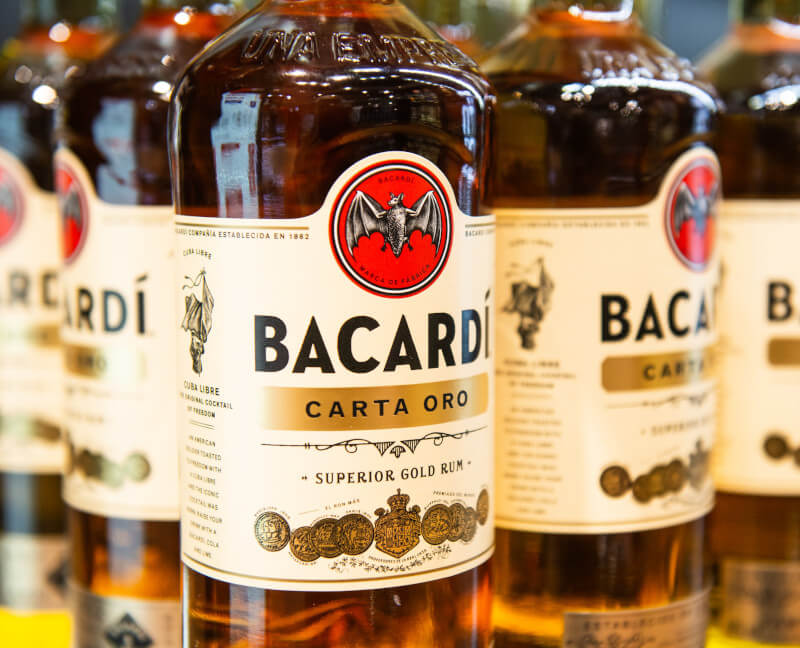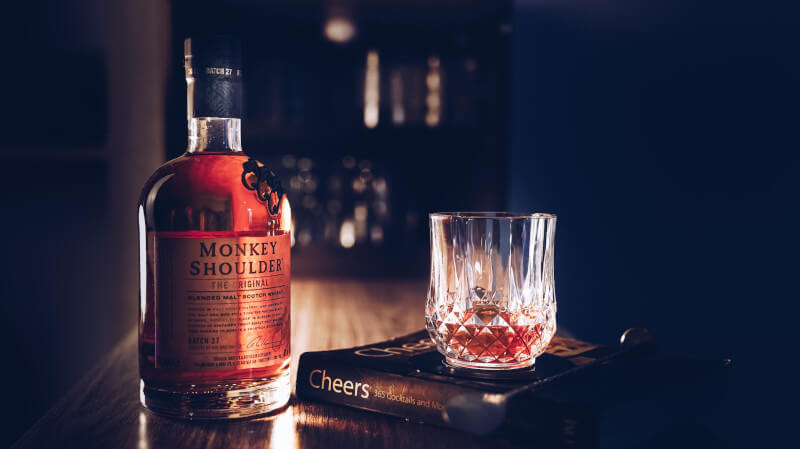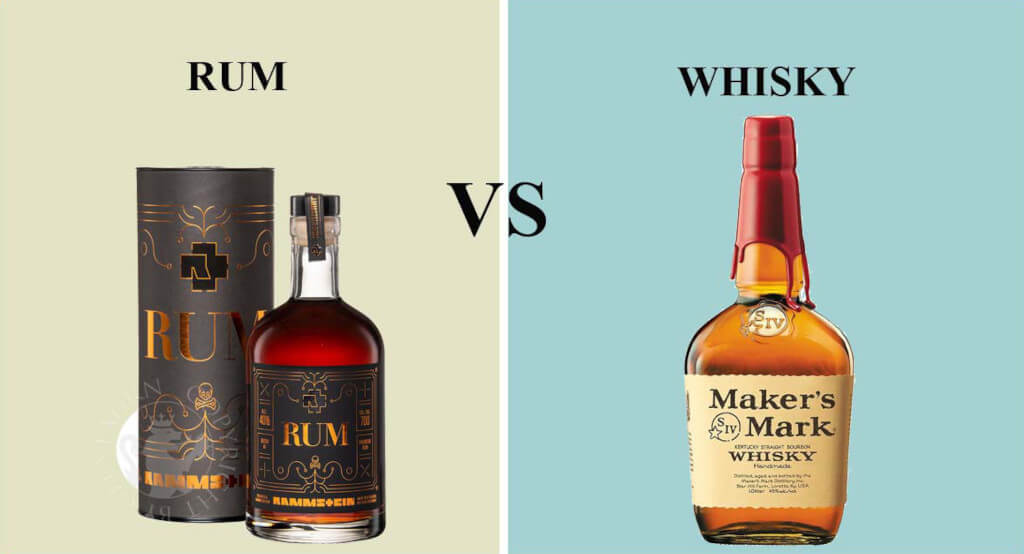There is a wide variety of alcoholic beverages available on the shelves of drinking establishments and private homes. There are many other types of alcoholic beverages available, but the top five are vodka, gin, tequila, rum, and whiskey.
Clear spirits include vodka and gin, whereas tequila ranges from colorless to pale amber, rum goes from colorless to dark brown, and whiskey, of course, is a uniform golden amber to dark woody brown. Dark rum and whiskey, as you may have guessed, taste different than their transparent counterparts. Exactly how dissimilar are rum and whiskey, then?
What Is Rum?
Let’s hop on a plane and head to the Caribbean so we can study the region’s most well-known product. Many pirate adventures have been fueled by this spiced spirit and for good reason. On a hot summer day, rum in any of its many cocktail forms is the ideal beverage. But what, precisely, is rum?
Distilled from sugarcane juice or molasses, rum is a type of alcoholic beverage. Vanilla, cinnamon, and nutmeg are just a few of the ingredients that give it its signature taste. The finest rums are those that have been matured in oak barrels, which impart a subtle and pleasant flavor.

Rum can be enjoyed straight up or with ice, but it also works well in mixed drinks like the Pina Colada and the Mojito. When you’re craving something sugary and tropical, crack open a bottle of rum and cheers to the good life.
How Does One Make Rum?
An in-depth look into the rum-making procedure is provided below:
First Step: Sugarcane Collection
Cutting down sugarcane and bringing it to a manufacturing facility is the first step in making rum. Because of its tropical warmth and fertile soil, the Caribbean is a major producer of sugarcane and rum.
Step Two: Sugarcane Juice Extraction
Chopping and crushing the sugarcane yields the juice. The high concentration of sugar in sugarcane juice is essential to the fermenting procedure. The fermentation process cannot produce alcohol if sugar is not taken from the sugarcane.
Step Three: The Juice is Fermented
Rum goes through a fermentation process next. The sugarcane juice is combined with yeast in a fermentation tank to produce ethanol. Over a few days, the yeast ferments the juice, converting the carbohydrates into alcohol.
The components for fermentation are few and the technique is straightforward. Water and yeast are added to the sugar cane juice first. After a while, the yeast will have consumed all the sugar and produced alcohol from the mixture. The liquid that is produced once fermentation is finished is called wash. The wash contains more alcohol, but it’s still not as potent as rum or vodka. The greater proof can only be achieved by distilling the fermented sugarcane juices.
Step Four: The Juice is Distilled
The results of the distillation process, which is crucial to the production of rum, are quite remarkable. Using a pot still or a column still are the two most common distillation techniques. Most people use pot stills when they are scavenging.
First, fermented sugarcane juice is poured into a pot still and heated to boiling using a pot still distillation process. Since the alcohol vapors boil before the water, they contain more alcohol and less of the other elements in the mash than the liquid. The procedure of collecting the vapors and condensing them back into liquid is repeated until the rum reaches the desired purity level.
Final Step: Ageing
A lot of rums aren’t mature. Unlike dark rum, clear rum does not require any aging before being bottled. Some dark rums aren’t aged at all; instead, they get their color and flavor from additives like caramel and spices.
However, many darker rums get their dark color from aging in oak barrels. Wood’s natural botanicals, flavors, and colors are absorbed by the liquor during the aging process when the wood expands and compresses. When aged, spirits take on the subtle flavors of the wood they were stored in. The aging process gives rum its distinctive flavor. For instance, most rums are matured for about a year, while black rums might be aged for a minimum of three years.
What Is Whiskey Compared To Rum?
Whisky is an alcoholic drink that is distilled from fermented barley mash. Barley, rye, wheat, and maize are all viable options for the grains. The characteristic color and flavor of whiskey are acquired through the aging process in wooden barrels.
Whiskey derives from the Gaelic for “water of life,” uisce beatha. Whiskey’s popularity has skyrocketed over the years, yet it’s been around for centuries. These days, you may pick from a wide variety of whiskies, each with its distinct taste.

American consumers tend to favor bourbon and rye whiskey. American-made bourbon whiskey must also include at least 51 percent maize to qualify. However, to be called rye whiskey, the percentage of rye grain must be at least 51%. Additional criteria include minimum ages and age limitations.
How Does One Make Whiskey?
Whiskey production is quite similar to rum production. All alcoholic beverages go through essentially the same process of harvesting, fermenting, distilling, and aging.
Whiskey’s distinctive flavor comes from a different fermenting method. The grains are ground and combined with hot water to make a porridge-like mixture that will be fermented rather than crushed and juiced. This method is more efficient in releasing the sweet carbohydrates in the cereal grains, making them more readily fermentable by yeast.
Other than that, the procedure is very similar to running, even down to the aging and distillation of the pot. Even while most whiskies have more stringent aging requirements, the fundamental idea stays the same.
In What Ways Do Rum and Whiskey Differ From One Another?
Here’s a quick rundown of the fundamental distinctions between rum and whiskey:
- Rum’s primary ingredient is sugarcane, while whiskey typically uses corn, wheat, rye, or barley.
- The aging process is mandatory for whiskey but optional for rum.
- Rum can be either clear or dark in color. Whiskey, on the other hand, is often a dark or amber color.
- Whiskey has a more traditional smoky or peaty flavor, while rum is more commonly sweet.
- While most whiskies do not have flavor additives, any rum can be spiced rum because of the addition of flavorings and spices. Flavoring is illegal for many whiskies.
- That settles the matter, then! The distinctions between rum and whiskey are described above.
In What Ways Are Rum and Whiskey Comparable?
While rum and whiskey are each distilled from various sources and feature distinctive flavors, they do share some commonalities. Some of these shared features are examined in further detail below:
- Spirits like rum and whiskey go through the distillation process. This means that the liquids are filtered and the alcohol concentration is increased after fermentation. Beer and wine are fermented products, but they are not distilled like this.
- While it’s not required, aged rum has many of the same characteristics as whiskey.
- Much of the complexity and depth of color in a fine whiskey or rum can be attributed to its aging. A liquor’s color will deepen as it ages.
- Flavors associated with the wood used in the aging process are shared by both dark rum and whiskey. Liquors that have been aged in various kinds of wood tend to take on notes of caramel and vanilla.
What We Know Now About Whiskey & Rum?
Whiskey is an alcoholic drink that is distilled from fermented barley mash. Common cereal grains include wheat, corn, rye, and barley. Whiskey’s flavor and hue come from the time it spends aging in wooden barrels. The United States, Ireland, and Scotland are the top three producers of whiskey in the world.
Many varieties of whiskey exist, each with its distinctive taste. Bourbon and rye are the two most widely consumed whiskies in the USA. A minimum of 51% corn must be used in the production of American-made bourbon. At least 51% of rye must be present in rye. Age limits and minimums are two other common regulations.
The fermentation phase is where rum and whiskey diverge most significantly. Whiskey is distilled from cereal grains like corn, wheat, rye, and barley, whereas rum is distilled from sugarcane. Whiskey is often an amber or brown color, while rum comes in both clear and dark varieties. Whiskey has a smoky or peaty flavor, while rum has a more usual sweet flavor.

